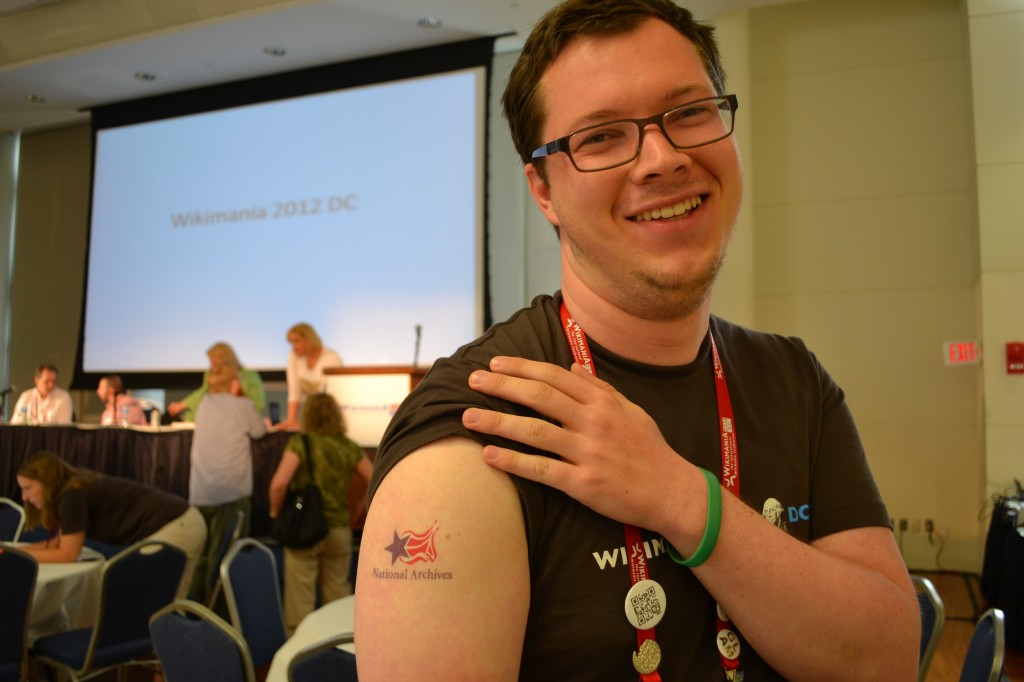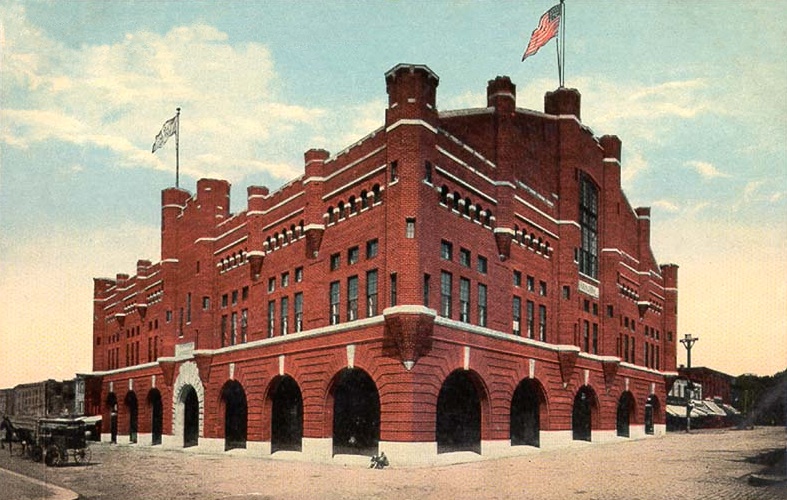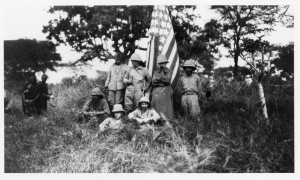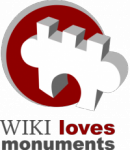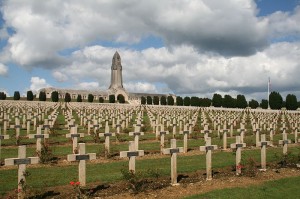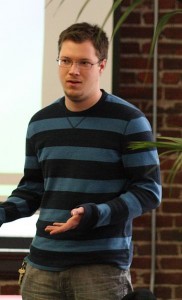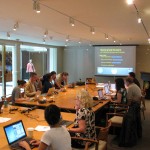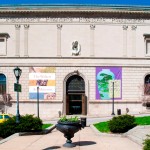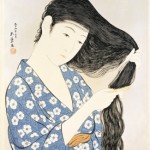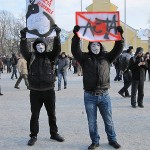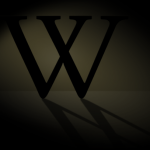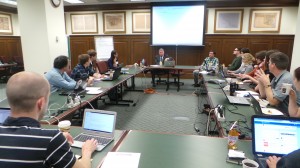
Participants at GLAM Boot Camp in Washington, D.C.
Recently, Wikimedia DC held GLAM Boot Camp, a new type of event which we hope will be repeated by others in the Wikimedia movement. The most basic aim of GLAM Boot Camp was to attempt to build the skills and capacity for the Wikimedia movement. It took place from April 26–28 in a conference room at the U.S. National Archives with 12 main attendees made up of experienced Wikimedia editors. The intensive, three-day workshop, hosted by myself and Lori Byrd Phillips, featured a mix of expert presentations, group discussions, breakout sessions, and hands-on tutorials. We were lucky enough that one of the Wikimedians in attendance wrote about the event in The Signpost, English Wikipedia’s newsletter, which gives a good recap of GLAM Boot Camp from a participant’s point of view.
The idea for a “boot camp”-type event was first proposed and developed at GLAMcamp London by members of the global Wikimedia community in September 2012. You can see our original notes from GLAMcamp here. We identified that, particularly in the United States, our main efforts had always been directed at reaching out to and winning over cultural institutions, but now we face a lack of online and real-world volunteers ready to meet the growing demand of institutions interested in contributing in some way to Wikimedia. Many potential projects have stalled not because of lack of cooperation, but because of lack of involvement by the Wikimedia community. Institutions do not yet have the expertise in Wikipedia to become Wikimedians on their own. Our largest bottleneck in GLAM-Wiki, therefore, is capacity. The stated, ambitious goal of the first GLAM Boot Camp was to broaden the participation of the general Wikimedia community in the GLAM-Wiki movement by inviting and training key Wikimedians. I think that we were successful in taking a big step towards that goal. Another goal was to establish a model for future similar events, and I hope that as we work on our documentation, others will be able to use our experiences to guide them in making another GLAM Boot Camp elsewhere.
All of us who have been to events like GLAMcamp or Wikimania know that oftentimes the most important part is not the structured sessions, but just being with a group people for a couple of days and sharing perspectives—even over coffee or back at the hostel. The main takeaways for me at these events were about the attendees. The fact that we fully funded all attendees from across the U.S. and Canada was integral to ensuring we were able to recruit new participants. Second, we specifically invited the people we thought would be key, rather than hoping people would sign up. This ended up making even more sense in retrospect, because we were so happy with who came, but if the idea was to reach people who were not normally part of GLAM-Wiki projects, we were trying to reach people who wouldn’t already be following our normal channels of communication and who would not inclined to sign up, even if they heard about it or were familiar with the goals of GLAM-Wiki. The geographic diversity of the participants we invited allowed us to hold an event with a variety of online experiences, and to provide Wikimedians who may not have been able to attend a meetup before to get to meet other Wikimedians face-to-face.
As co-organizer, I want to tease out a few more important points:
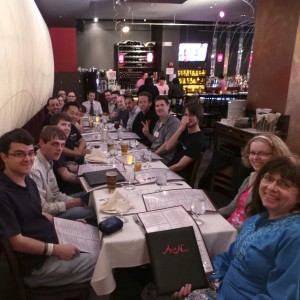
GLAM Boot Camp attendees enjoying dinner together after a day of hard work.
Attendees
We posted a list of attendees to the page; the names in green were those who we invited as full participants for the entire event. Of these, only about three had actually signed up or registered interest before we started sending out invitations. For the others, I spent hours looking for people; asking for opinions of others; and looking through user contributions of people who had participated in any GLAM WikiProjects online, in meetups, or in any of various other Wikimedia activities or subcommunities (such as administrators and featured content writers). Participants came from all over the United States (New York; Maryland; Los Angeles; San Francisco; Portland, Ore.; Philadelphia; Kansas; Michigan; and Chicago) and Canada (Halifax, Vancouver, and Winnipeg). No two people were from the same metropolitan area, and most came from areas without regular Wikipedia-related events. For many, this was their first time at a Wikipedia event of any kind. The size of the group, 12 invited attendees with no more than five organizers and guests, was the perfect amount to allow for productive discussions.
Program
We designed a program that was very unlike GLAMcamp and a lot more structured than most unconferences, but with more practical sessions than a traditional conference. It was something between a Wikipedia Academy, where newcomers are taught how to edit Wikipedia, and a campus ambassador training. You can see our program here. We generally moved from presentation-heavy to discussion-heavy sessions. The first day was our high-level overview of, and introduction to, cultural institutions and the history and present circumstances of GLAM-Wiki. Michael Edson’s inspiring opening talk was to give participants an insider perspective of cultural institutions, and we talked a lot about institutional missions and how to connect the work of Wikimedia with that of cultural institutions. The second day we moved into more practical matters, going through the whole “lifecycle” of a Wikimedia project, and talking about specific events and projects. By the third day, we spent more time in discussion, getting the boot campers to articulate their own visions of GLAM-Wiki and how they personally could contribute to it. We ended up having unplanned breakout sessions a couple of times because attendees were excited with ideas as we showed them things like our one-page guide that needed improvement. If you would like to dig into the Etherpad notes from each day, they are listed at the top of the program, linked above.
Logistics
The event was possible for us in the U.S. because logistics and funding were largely handled by James Hare and Wikimedia DC, which budgeted $8,000 for the conference from its program budget. Most of the money went towards funding the travel and accommodations of the attendees. All attendees were fully funded, and this was crucial. Most of the travelers had their flights booked by Wikimedia DC and stayed in a hostel (same as the one used for Wikimania 2012 and GLAMcamp DC). Wikimedia DC also hosted two dinners and provided refreshments throughout the day.
Speakers
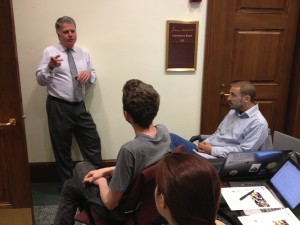
David Ferriero talking to attendees at GLAM Boot Camp.
The ambitious nature of the workshop, with three full days of programming, meant Lori and I spoke a lot. We broke things up a little by inviting special speakers in certain topic areas, often where they had as much or more expertise as either of us did. Some of these speakers were locals from the DC area that agreed to come in, and some were attendees we invited to present to the group on something they are skilled at. Examples include the Wikisource and Commons workshops, a session on event planning, and a session on grants and chapters. We also led off with special guests: Archivist of the United States David Ferriero gave a welcome address, and Michael Edson, who had just returned from keynoting GLAM-Wiki London, gave an epic talk for most of the first morning. At least half of the sessions were led by Lori or I, though, and future GLAM Boot Camps probably would want to find ways not to give so much work to two individuals, for their own sanity. 😉
Venue
The venue was provided by the U.S. National Archives, though there were pros and cons for this. The main pro was that there was no cost associated with securing a venue! We might have been able to find a room elsewhere without a cost, but 3 days, all day for no cost is a big ask. The other main benefit was that we were in a good location and were able to take advantage of having David Ferriero make appearances. We did face typical problems with working with a bureaucratic venue, like catering and security all taking more time than we wanted.
Outcomes
For me, the most important outcome was seeing attendees who were all not the same old faces come in, eager to get involved. Gradually, they took more ownership and responsibility for GLAM-Wiki, as they began to feel more empowered and a part of the effort. There were practical outcomes, like specific documentation or project pages to improve. More than that, though, most attendees came away intent on contacting local institutions or organizing their local Wikipedia community. I am as excited by the overall community-building I think we did around GLAM-Wiki, which will help it be more successful as it is more accepted and integrated with the Wikipedia community, as I am by any specific skills attendees may have learned or GLAM projects they may go off and start.
The need to reach out more to the Wikimedia community, as much as to cultural institutions, is something I feel very strongly about, so I am so glad we were able to hold this event, and grateful to everyone who made it possible and attended.

